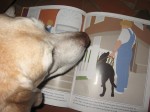 Today, January 29, is National Seeing Eye Dog Day. A day to recognize the JOY that is a working guide dog. A seeing eye dog becomes the eyes for someone who cannot see. They become an unbeatable team!
Today, January 29, is National Seeing Eye Dog Day. A day to recognize the JOY that is a working guide dog. A seeing eye dog becomes the eyes for someone who cannot see. They become an unbeatable team!
It all started with a serendipitous intertwining of a few forward thinking individuals. A lot of veterans came away from the terror that was World War I, blinded and in need of assistance. A school was set up in Germany to train German Shepherd Dogs to assist these veterans. An American lady, Ms Dorothy Eustis, happened to be in Switzerland and learned about this German school. She was so impressed that in 1927 she wrote an article for “The Saturday Evening Post” about these “seeing eye dogs.” And she began her own training school. In America, a blind man, Mr Morris Frank was read the article by his father and he decided that a seeing eye dog was just what he needed! He contacted Ms Eustis to see if he could come train with her and receive one of her dogs. He promised to come back to the United States and teach others.
 In 1928 Buddy, the German Shepherd, became the first seeing eye dog in the United States and Mr Frank was the first blind person in the US to use a seeing eye dog! And in 1929 The Seeing Eye Guide Dog School was established in Nashville, Tennesseee. In 1966 the school moved to its present location, Morristown, New Jersey. It is the oldest existing guide dog school in the US.
In 1928 Buddy, the German Shepherd, became the first seeing eye dog in the United States and Mr Frank was the first blind person in the US to use a seeing eye dog! And in 1929 The Seeing Eye Guide Dog School was established in Nashville, Tennesseee. In 1966 the school moved to its present location, Morristown, New Jersey. It is the oldest existing guide dog school in the US.
I came from a Guide Dog school, myself. Southeastern Guide Dogs in Palmetto, Florida.
 That ultimately was not my destiny, but we stay connnected to the school and continue to raise pups for them. Our little Dogzilla, Electra, is one such pup. And we also like to educate folks about guide dogs.
That ultimately was not my destiny, but we stay connnected to the school and continue to raise pups for them. Our little Dogzilla, Electra, is one such pup. And we also like to educate folks about guide dogs.
 This is our friend Mr Allen Preston and his guide dog Jolly doing a presentation at our school. Jolly was a pup that we raised for Southeastern Guide Dogs and ultimately for Mr Preston.
This is our friend Mr Allen Preston and his guide dog Jolly doing a presentation at our school. Jolly was a pup that we raised for Southeastern Guide Dogs and ultimately for Mr Preston.
For more information about Guide Dogs visit The National Association of Guide Dog Users website HERE.
For more information about blindness visit the National Federation of the Blind website HERE.
To find out what day to day life is like for a working guide dog team visit Jo and Wiley at their blog Daily Life of a Guide Dog HERE.
Find out more about Michael Jernigan HERE and HERE.
And here is Mr Morris Frank in his own words —
I hope that you will do a little research today and learn what you can about Seeing Eye Dogs and the kind of difference they make in a blind person’s life.
Wishing you a day of thankful independence!
Your friend
Rhythm


































